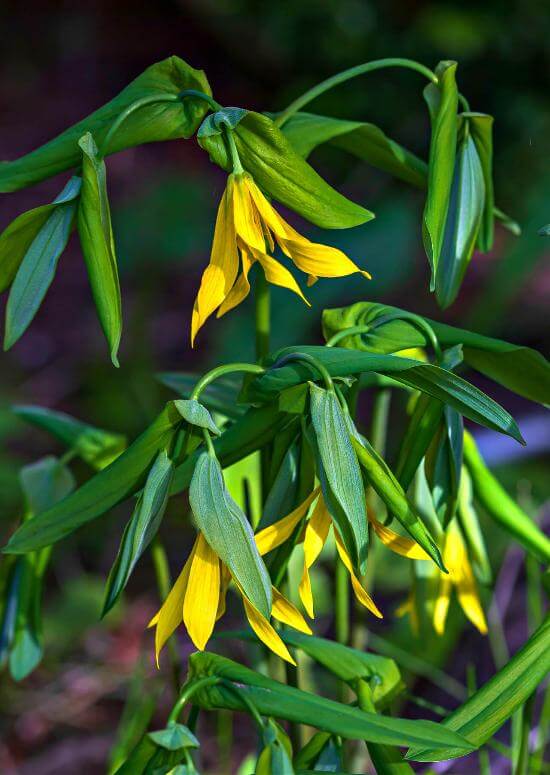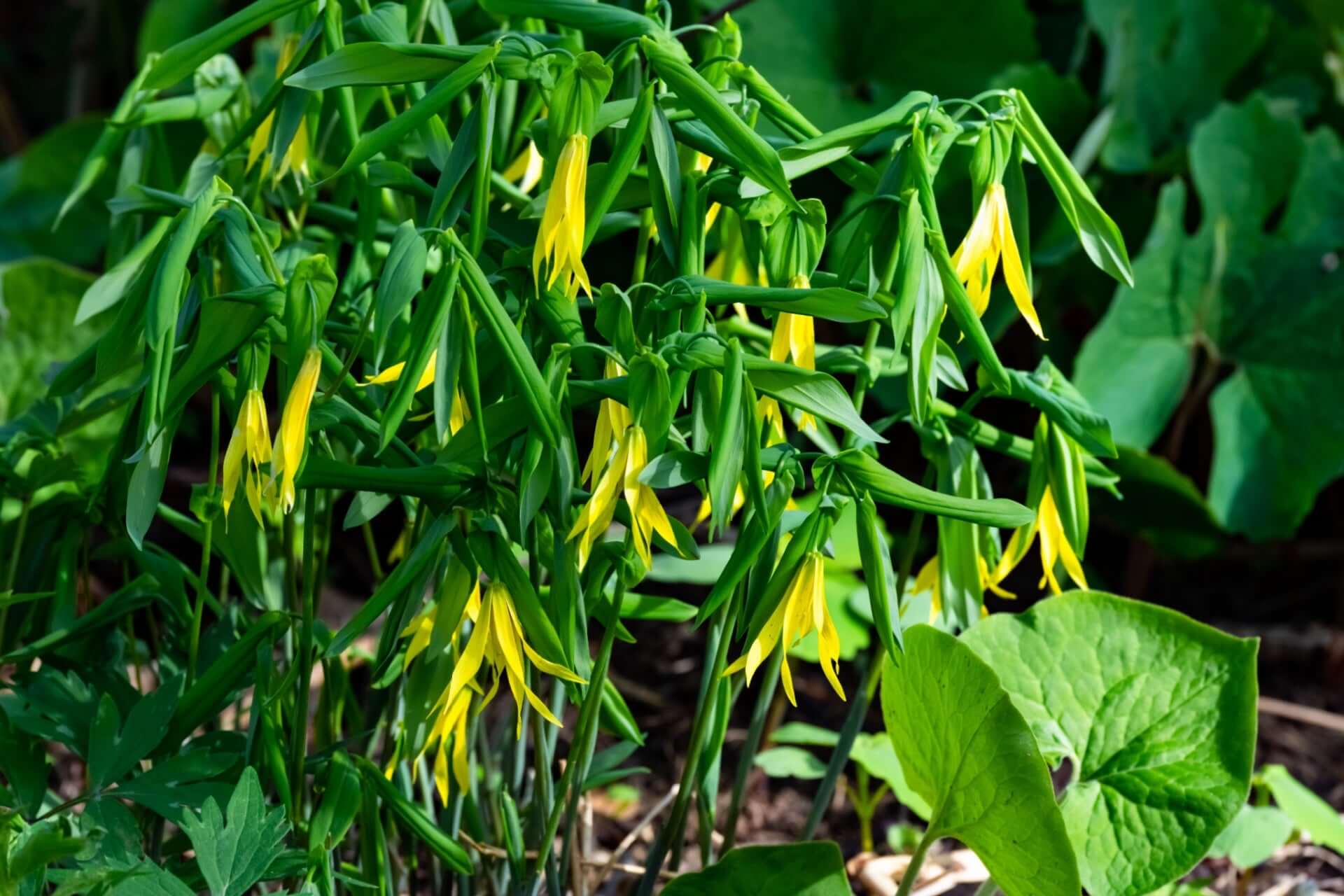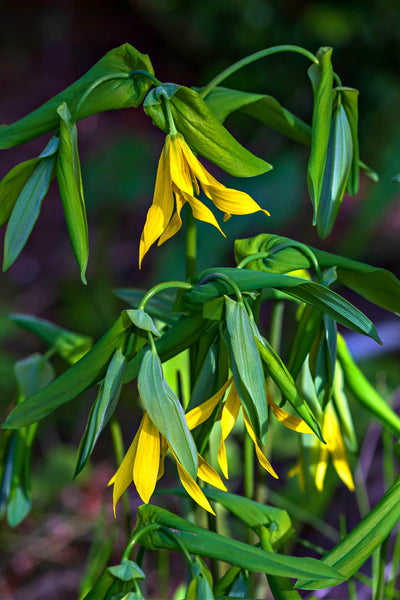Bellwort, a native woodland perennial, is a captivating plant that graces shaded gardens with its delicate, drooping yellow flowers. Known scientifically as Uvularia, this plant is sometimes referred to as Merry Bells or Straw-lily due to the whimsical appearance of its blooms. Bellwort offers any garden a soft, enchanting beauty, making it a favorite among those looking to create a tranquil, naturalized landscape. Its subtle charm pairs beautifully with ferns, hostas, and other woodland plants, creating a serene, layered texture in shaded garden corners.
It reaches two feet tall and spreads through creeping rhizomes, creating a soft mat of green foliage. Its thin, lance-shaped leaves gently curve, offering a nodding elegance to the overall appearance. In spring, Bellwort produces pale yellow, bell-shaped flowers that dangle delicately from arching stems. These understated yet graceful flowers glow gently in shady areas where more vibrant blooms may struggle to thrive.
Does Bellwort spread?
Bellwort has a modest yet steady method of spreading. Unlike aggressive plants that can overtake garden spaces, Bellwort spreads slowly through underground rhizomes. Over time, this creates small plant colonies, gently filling spaces with airy foliage and soft yellow blooms. Its spreading nature makes it ideal for naturalizing shaded areas, where it can weave through other plants without overpowering them. The key to managing Bellwort's spread is providing the right environment. Bellwort will slowly but surely expand its presence in rich, well-drained soil with consistent moisture. This is particularly helpful for those wanting to create a naturalized woodland garden where plants coexist harmoniously rather than competing for space.
Gardeners often find Bellwort's spread a welcome feature, as it adds a softness and continuity to shady areas. It's a plant that works quietly, filling in gaps without causing disruption. Over time, it creates a low, subtle carpet of greenery, making it a valuable plant for covering bare ground beneath trees or along woodland paths. Its spread can be encouraged through gentle division every few years, ensuring the plants remain healthy and vibrant.
Where to plant Bellwort?
Bellwort thrives in the dappled light and rich, loamy soils of woodlands, making shaded garden spaces its ideal home. When planting Bellwort, look for spots resembling its natural habitat, such as beneath deciduous trees or in areas with filtered sunlight. It prefers moist, well-draining soil rich in organic matter, so adding compost or leaf mulch to the planting spot can help supply the nutrients it needs to flourish. Bellwort's delicate beauty shines alongside other woodland perennials, such as ferns, Solomon's seal, and trillium. The soft interplay of textures and shapes creates a natural, layered effect that can transform even the most modest shaded garden into a serene, inviting space.

One of Bellwort's greatest strengths is its ability to thrive in difficult areas where other plants may struggle. Its love for shaded conditions means it can fill spaces beneath large trees or in north-facing garden beds where sunlight is limited. Despite its delicate appearance, Bellwort is quite resilient once established. It can handle periods of drought, although it will perform best with consistent moisture. Its preference for well-drained soil means it will not tolerate soggy conditions, so avoid planting it in areas that stay soggy after rainfall.
Bellwort also serves as an excellent companion plant. Its subtle nature allows more vibrant flowers to take center stage while its graceful, flowing stems fill the gaps. It works particularly well in gardens aiming for a naturalistic or wild look, where the goal is to create a sense of effortless beauty.
Is large-flowered Bellwort edible?
Yes, large-flowered Bellwort (Uvularia grandiflora) is indeed edible, though its culinary use is not widely practiced today. Indigenous peoples once used the plant for its medicinal and edible qualities. The tender shoots of Bellwort, harvested in early spring, were sometimes eaten raw or lightly cooked. Though rare in modern kitchens, they have a mild flavor, similar to asparagus. The roots of Bellwort were also used medicinally, often in poultices, to help treat wounds or reduce swelling.
While large-flowered Bellwort is not toxic and can be consumed, it's essential to approach its use carefully, as it is not widely recognized as a culinary plant today. For those interested in foraging or experimenting with wild edibles, always ensure that you are confident in your plant identification and that you harvest responsibly from areas where the plant is abundant.
What is a merry bell?
A "merry bell" is a whimsical name given to the bellwort plant due to the shape and appearance of its flowers. The dangling, bell-shaped blooms are cheerful, almost playful, particularly when they sway gently in the breeze. The term "merry bells" captures the spirit of this delicate plant, which brings quiet joy to the garden with its soft yellow flowers and graceful, nodding stems.
In the language of flowers, Bellwort's cheerful appearance symbolizes humility and resilience, It thrives quietly in shaded, often overlooked garden areas. It's a plant that does not demand attention but offers a subtle beauty that grows more enchanting with time. As its flowers bloom in early spring, Bellwort often signals the arrival of warmer weather, bringing a sense of renewal and optimism to the garden. The soft, pendulous flowers seem to nod in agreement, enhancing the plant's reputation as a symbol of quiet contentment.
Bellwort's delicate form and soft yellow color make it an ideal plant for creating a serene, calming garden space. Whether nestled beneath tall trees or lining a shaded path, its merry bells bring an understated joy to any garden.


